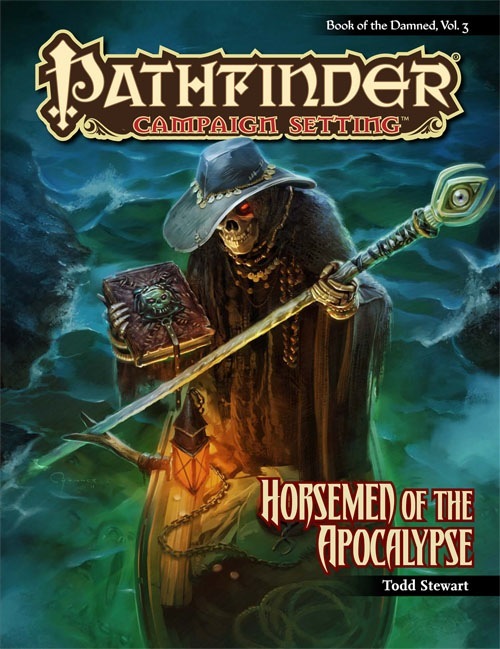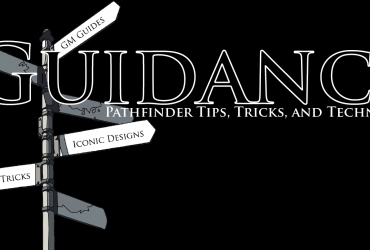Welcome to Guidance, Private Sanctuary’s source for tips and techniques for the Pathfinder Roleplaying Game, written by Everyman Gamer Alexander Augunas. Today, we’re going to be talking about the Book of the Damned, Volumes 1 through 3.
For the fifth (and final) installment of my Unbirthday Week special, I have a very strange review for you: TRIPLE FEATURE! In today’s product review, I’m going to be reviewing three related products AT THE SAME TIME. Pretty cool, eh? Remember, if you have any questions regarding my reviewing style, check no further than my Reviewing Products for Fun and … Fun article.
ONWARD!
Book of the Damned
The product that started it all, Book of the Damned is the evil counterpart to the Chronicles of the Righteous, which I reviewed yesterday, with one huge exception: the Book of the Damned consists of three separate products. Each part of the Book of the Damned focuses on one specific evil outsider race: Volume 1 focuses on devils and Hell, Volume 2 focuses on demons and the Abyss, and Volume 3 focuses on Daemons and Abbadon. I believe it makes perfect sense to review these three tomes together as one collective unit because of their shared themes, so that’s what I’m going to do! Here we go.
Crunch (Game Mechanics)
The three Books of the Damned follow a very similar crunch pattern: each possesses a handful of new monsters, a prestige class, and a couple of new spells. Depending upon which Volume you’re looking at, however, you get a couple of additional bits and pieces. For example, elements of the soul trade are detailed heavily in Volume 3, Horsemen of the Apocalypse while Volume 2 adds the Demonic Obedience feats, which were the precursors to the Celestial Obedience feats from yesterday’s Chronicles of the Righteous. All of the crunch in the Book of the Damned is wickedly horrifying in its approach, and not in an immature manner. Everything in this section oozes depravity and vileness, and it’s a much-needed tone considering the topic. The monsters added throughout these products are top-notch and range from CR 4 to CR 15 on average. This means that a veritable host of new demons, devils, and daemons are at your disposal upon purchasing this book, should you choose to accept them. All three books easily qualify for a 5 of 5 Star rating.
Flavor (Lore and Setting Information)
Book of the Damned has the same quality of flavor as Chronicles of the Righteous with one major difference: because the three fiendish races are spread across three different books, there is space to take a much deeper look at each type of fiendish race individually then there was in Chronicles of the Righteous. For example, Princes of Darkness, the devil supplement, finds the time to talk about many of the less powerful (but still notable) demigods among devilkind; it even includes a list of names, domains, and favored weapons to go with it. Lords of Chaos, the demon volume, includes an article on the qlipploth and their relation to demonkind. And all three articles include information about serving each race, transforming yourself into one of them, and even the hierarchies present in their fiendish courts if applicable. There is so much information about the fiendish races here that I honestly think that it requires several reads per volume until you start to truly see the nature of these entities through the eyes of the developer. An enjoyable read packed with flavor, I have no qualms awarding all three volumes 5 of 5 Stars.
Texture (Layout and Artwork)
Chronicles of the Righteous was a smudge weak in its layout, but the Book of the Damned does not suffer this weakness. For whatever reason, it is much easier to inspire an evil style than a goodly style; personally, I think it’s because as a culture we agree upon what’s evil, but not upon what’s good. Regardless, this book is littered with evil runes, black motifs, and illustrations that perfectly match this gloomy, hopeless color scheme. The sections are a little bit sporadic in these books and there aren’t good transitory pages, but that’s likely because of the sheer among of information that is crammed into each of these three supplements. In all, I find myself enjoying the dark colors and forbidden feel that the layout inspires much more than the bright, unfiltered yellow of the Chronicles of the Righteous. I’m more than happy awarding this section 4.5 of 5 Stars for how appropriate the layout feels, but it doesn’t inspire the same unity and cohesion as Champions of Balance, so I don’t feel comfortable giving it the full 5 star rating.
Final Score & Thoughts
Crunch: 5/5 Stars
Flavor: 5/5 Stars
Texture: 4.5/5 Stars
Final Score: 14.5/5 Stars, or 4.75 Stars/5, rounded up for its flavor.
Individually, the three volumes of the Book of the Damned are amazing, excellent reads. The fact that the series managed to hold the same level of quality throughout several years of printing and a slew of authors is a testament to Paizo’s mastery over the evil realms. These planes are ripe for use in adventures of all sorts, and I am pleased to have such a thorough, encompassing guide on the topic. I would highly recommend all three volumes to any GM’s toolbox: they will meet your needs and exceed them a hundred times over.
Alexander “Alex” Augunas has been playing roleplaying games since 2007, which isn’t nearly as long as 90% of his colleagues. Alexander is an active freelancer for the Pathfinder Roleplaying Game and is best known as the author of the Pact Magic Unbound series by Radiance House. Alex is the owner of Everyman Gaming, LLC and is often stylized as the Everyman Gamer in honor of Guidance’s original home. Alex’s favorite color is blue, his favorite Pathfinder Race/Class combination is kitsune demoniac … no. No it’s not. He hates playing evil characters.









Leave a Reply